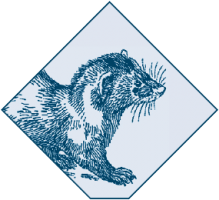Fur Farms

The majority of fur comes from fur farms. Some of these farms are sometimes located in places with poor quality soil or harsh climates. These are conditions that make most agricultural activities very difficult, however, fur animals can thrive in them.
Farmed fur animals o offer many ‘circular economy’ opportunities. For example, feed for mink and fox is primarily produced using waste products from the food supply chain (mostly from the chicken, beef, fish and dairy industries), offering a new production stream and reducing the volume of waste destined to landfill.
 The animals themselves also provide options for sustainability, particularly mink.
The animals themselves also provide options for sustainability, particularly mink.
When it’s processed into bone meal, the carcass has the same calorific value as wood chips. Bone meal from the animal is also used as a fertilizercomponent and is exported across Europe. Meanwhile, fat from the mink is used to produce biodiesel, which is added to fossil diesel. Biofuels ensure supply reliability, and, crucially, a reduction of CO2. The EU has adopted a directive that obliges countries to use 10% renewable energy in the transport sector by 2020. Mink fat is making a significant contribution to this.
 According to a survey by Fur Europe from October and November 2012, as many as 68.42% of fur animals are used in their entirety. Danish mink breeders are at the forefront of reaching 100% — now a stated aim of the sector overall. In Finland the fur animals are used in their entirety and nothing in wasted. As there are minks, fox and Finnraccoons in Finland, crossfeeding is possible and therefore the carcasses can be used as part of the animal feed.
According to a survey by Fur Europe from October and November 2012, as many as 68.42% of fur animals are used in their entirety. Danish mink breeders are at the forefront of reaching 100% — now a stated aim of the sector overall. In Finland the fur animals are used in their entirety and nothing in wasted. As there are minks, fox and Finnraccoons in Finland, crossfeeding is possible and therefore the carcasses can be used as part of the animal feed.
Similarly, the by-products of fur farming rarely end up unutilized. Manure, thanks to its high phosphorus content and lack of alien seed, is an excellent primary material for organic fertilizers.
Fur farm certification
In 2018, commissioned by the Russian Fur-Fur Union and supported by the IFF Moscow State Veterinary Academy conducted research on compliance with the rules and conditions for keeping and breeding of fur animals in Russia meeting European standards.
Based on the results of the research, the scientifically grounded Rules for keeping and breeding of fur-bearing fur animals in Russian fur farms that meet the requirements of the Recommendations of the Council of Europe Standing Committee on Compliance with the European Convention for the protection of animals raised on the farm at the present stage were developed and published in the form of books.
This work forms the basis of IFF's global projects, such as Furmark and Welfur in Eurasia Region and will be used for farming certification in Russia and Belorussia.
Starting from 2020 international fur auctions will sell only certified fur skins.
